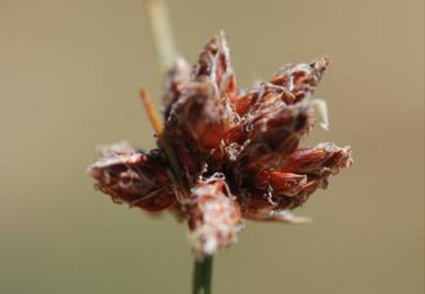Abstract
Despite over 300 years of botanical inventory, new species continue to be discovered within the Greater Cape Floristic Region of South Africa. Recent field work in the ecotone of the Fynbos and Succulent Karoo biomes has revealed three species of Ficinia that are new to science. Based on field observation and comparison with existing material in major herbaria, we describe and name F. bolusiana, F. stirtonii and F. swartruggensis.
References
Goetghebeur, P. (1998) Cyperaceae. In: Kubitzki, K. (Ed.) The families and genera of vascular plants 4, Springer, Berlin, pp. 141–190. https://doi.org/10.1007/978-3-662-03531-3_15
IUCN (2022) Guidelines for using the IUCN red list categories and criteria, version 15. Gland, Switzerland, and Cambridge, UK: IUCN.
Larridon, I., Zuntini, A.R., Léveillé-Bourret, É., Barrett, R.L., Starr, J.R., Muasya, A.M., Villaverde, T., Bauters, K., Brewer, G.E., Bruhl, J.J., Costa, S.M., Elliott, T.L., Epitawalage, N., Escudero, M., Fairlie, I., Goetghebeur, P., Hipp, A.L., Jiménez-Mejías, P., Sabino Kikuchi, I.A.B., Luceño, M., Márquez-Corro, J.I., Martín-Bravo, S., Maurin, O., Pokorny, L., Roalson, E.H., Semmouri, I., Simpson, D.A., Spalink, D., Thomas, W.W., Wilson, K.L., Xanthos, M., Forest, F., Baker, W.J. (2021) A new classification of Cyperaceae (Poales) supported by phylogenomic data. Journal of Systematics and Evolution 59: 852– 895. https://doi.org/10.1111/jse.12757
Levyns, M.R. (1947) Notes on Ficinia and descriptions of four new species. Journal of South African Botany 13: 66–74.
Linnaeus, C. von. (1771) Mantissa Plantarum Altera. Generumeditionis VI & specie rumeditionis II. Holmiae [Stockholm].
Manning, J. & Goldblatt, P. (Eds.) (2012) Plants of the Greater Cape Floristic Region 1: the Core Cape flora, Strelitzia 29. South African National Biodiversity Institute, Pretoria, pp. 870.
Muasya, A.M. (2017) From alpha taxonomy to genomicsin South Africa: one of the hottest biodiversity hotspots. In: Friis, I. & Balslev, H. (Eds.) Tropical Plant Collections: Legacies from the Past? Essential Tools for the Future? The Royal Danish Academy of Sciences and Letters, Copenhagen, pp. 320.
Muasya, A.M. & Larridon, I. (2021) Delimiting the genera of the Ficinia Clade (Cypereae, Cyperaceae) based on molecular phylogenetic data. PeerJ 9: e10737. https://doi.org/10.7717/peerj.10737
Nees von Esenbeck (1833) Analecta ad FloramCapensem. Linnaea 8: 75–94. [https://www.biodiversitylibrary.org/item/109830]
Nees von Esenbeck (1836) Cyperaceae Capenses secundum novissimas Ecklonii collections. Linnaea 10: 129–207.
Schrader, H.A. (1832) Ficinia. Commentiones Societatis Regiae Scientiarum Gottingensis. Recentiores 7: 143–147.
Snijman, D.A. (Ed.) (2013) Plants of the Greater Cape Floristic Region. 2: The Extra Cape flora. Strelitzia 30. South African National Biodiversity Institute, Pretoria, pp. 557.
Thiers, B. (2022 [continuously updated]) Index Herbariorum: A global directory of public herbaria and associated staff. New York Botanical Garden’s Virtual Herbarium. Available from: http://sweetgum.nybg.org/ih/ (accessed 5 January 2021)
IUCN (2022) Guidelines for using the IUCN red list categories and criteria, version 15. Gland, Switzerland, and Cambridge, UK: IUCN.
Larridon, I., Zuntini, A.R., Léveillé-Bourret, É., Barrett, R.L., Starr, J.R., Muasya, A.M., Villaverde, T., Bauters, K., Brewer, G.E., Bruhl, J.J., Costa, S.M., Elliott, T.L., Epitawalage, N., Escudero, M., Fairlie, I., Goetghebeur, P., Hipp, A.L., Jiménez-Mejías, P., Sabino Kikuchi, I.A.B., Luceño, M., Márquez-Corro, J.I., Martín-Bravo, S., Maurin, O., Pokorny, L., Roalson, E.H., Semmouri, I., Simpson, D.A., Spalink, D., Thomas, W.W., Wilson, K.L., Xanthos, M., Forest, F., Baker, W.J. (2021) A new classification of Cyperaceae (Poales) supported by phylogenomic data. Journal of Systematics and Evolution 59: 852– 895. https://doi.org/10.1111/jse.12757
Levyns, M.R. (1947) Notes on Ficinia and descriptions of four new species. Journal of South African Botany 13: 66–74.
Linnaeus, C. von. (1771) Mantissa Plantarum Altera. Generumeditionis VI & specie rumeditionis II. Holmiae [Stockholm].
Manning, J. & Goldblatt, P. (Eds.) (2012) Plants of the Greater Cape Floristic Region 1: the Core Cape flora, Strelitzia 29. South African National Biodiversity Institute, Pretoria, pp. 870.
Muasya, A.M. (2017) From alpha taxonomy to genomicsin South Africa: one of the hottest biodiversity hotspots. In: Friis, I. & Balslev, H. (Eds.) Tropical Plant Collections: Legacies from the Past? Essential Tools for the Future? The Royal Danish Academy of Sciences and Letters, Copenhagen, pp. 320.
Muasya, A.M. & Larridon, I. (2021) Delimiting the genera of the Ficinia Clade (Cypereae, Cyperaceae) based on molecular phylogenetic data. PeerJ 9: e10737. https://doi.org/10.7717/peerj.10737
Nees von Esenbeck (1833) Analecta ad FloramCapensem. Linnaea 8: 75–94. [https://www.biodiversitylibrary.org/item/109830]
Nees von Esenbeck (1836) Cyperaceae Capenses secundum novissimas Ecklonii collections. Linnaea 10: 129–207.
Schrader, H.A. (1832) Ficinia. Commentiones Societatis Regiae Scientiarum Gottingensis. Recentiores 7: 143–147.
Snijman, D.A. (Ed.) (2013) Plants of the Greater Cape Floristic Region. 2: The Extra Cape flora. Strelitzia 30. South African National Biodiversity Institute, Pretoria, pp. 557.
Thiers, B. (2022 [continuously updated]) Index Herbariorum: A global directory of public herbaria and associated staff. New York Botanical Garden’s Virtual Herbarium. Available from: http://sweetgum.nybg.org/ih/ (accessed 5 January 2021)


